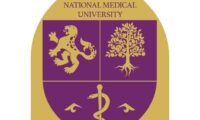Получена: 10.03.2023 / Принята: 07.08.2023 / Опубликована online: 31.08.2023
УДК 615.015; 615.035.4; 615.281; 615.035.1/.9
DOI 10.53511/PHARMKAZ.2023.51.32.017
Александр Е. Гуляев1, Зарина Т. Шульгау1, Татьяна Н. Криворучко1, Жаныбек Т. Бокебаев 2 , Ерлан М. Раманкулов1
1ТОО «Национальный центр биотехнологии», г. Астана, Казахстан
2НАО «Медицинский университет Астана», г. Астана, Казахстан
ПРИМЕНЕНИЕ ПЛЕОТРОПНЫХ ЭФФЕКТОВ АНТИБИОТИКОВ
ПРИ ЛЕЧЕНИИ SARS-COV-2
Резюме: Пандемия COVID-19 резко обострила вопрос рациональности и обоснованности антбиотикотерапии в ситуациях, когда у врачей нет полной уверенности в решающей значимости бактериального фактора в развитии патологии. Именно широта использования антибиотиков в лечении пациентов
с Covid-19, даже без явных признаков присоединения вторичной бактериальной инфекции, явилась
побудительным мотивом попытки описать плеотропные свойства антибиотиков. В широкой медицинской практике под плейотропией понимают множественность эффектов одного и того же лекарственного средства. Помимо, безусловного антибактериального эффекта, антибиотики обладают некоторыми противовирусными свойствами.
Цель: Рассмотреть дополнительные эффекты антибиотиков и попытаться показать, что формально есть основания для рассмотрения возможности применения плеотропных свойств антибиотиков
при инфекции SARS-CoV-2.
Стратегия поиска: Проведен обзор литературы ― публикаций отечественных и зарубежных исследователей, посвященных антибактериальной терапии при COVID-19 с использованием научных поисковых библиотечных баз данных PubMed, Web of science, Medline, Cochrane, Elibrary. Основной отбор
материалов осуществлялся по ключевым словам с учетом критериев включения и исключения. Всего было отобрано 97 литературных источников, в которых рассматривались данные о плеотропных
свойствах различных групп антибиотиков. Также проанализирированы публикации о применении антибиотиков при пандемии COVID-19.
Обсуждение: В настоящем обзоре, предприняты попытались показать, что некоторые антибиотики,
помимо их антибиотической активности, обладают плеотропными свойствами, среди которых выделяется антивирусный эффект, иммуномодулирующие и противовоспалительные свойства. По мнению
авторов, есть определенные и особые основания выделять некоторые антибиотики в качестве кандидатных соединений для исследования на активность против инфекции SARS-CoV-2 и в качестве
кандидатных соединений, препятствующих развитию и формированию легочного фиброза при вирусных пневмониях.
Ключевые слова: пандемия, антибактериальная терапия, доказательная база, плеоторопный эффект, противовирусная активность.
СПИСОК ЛИТЕРАТУРЫ
1 F.Zhou,T.Yu, R.Du,G.Fan,Y.Liu,Z.Liu,et al. Clinical course and risk factors for mortality of adult inpatients with COVID-19 in Wuhan, China: a retrospective
cohort study The Lancet., 395 (10229) (2020), pp. 1054-1062.
2 Chen N, Zhou M, Dong X, et al. Epidemiological and clinical characteristics of 99 cases of 2019 novel coronavirus pneumonia in Wuhan, China: a descriptive
study. Lancet. 2020 Feb 15; 395(10223):507-513.
3 Wang D, Hu B, Hu C, et al. Clinical Characteristics of 138 Hospitalized Patients With 2019 Novel Coronavirus-Infected Pneumonia in Wuhan, China. JAMA.
2020 Mar 17; 323(11):1061-1069.
4 Huang C, Wang Y, Li X, et al. Clinical features of patients infected with 2019 novel coronavirus in Wuhan, China. Lancet. 2020 Feb 15; 395(10223):497-506.
5 Marie Chedid, Rami Waked, Elie Haddad, et al. Antibiotic usage in 2019 coronavirus disease (Covid-19) treatment: a rapid review on frequency, indications,
and efficacy. Journal of Infection and Public Health Available online 9 February 2021 https://doi.org/10.1016/j.jiph.2021.02.001.
6 Fohner AE, Sparreboom A, Altman RB, Klein TE PharmGKB summary: Macrolide antibiotic pathway, pharmacokinetics/pharmacodynamics. Pharmacogenet
Genomics. 2017 Apr; 27(4):164-167.
7 Dinos GP The macrolide antibiotic renaissance. Br J Pharmacol. 2017 Sep; 174(18):2967-2983.
8 Labro MT, el Benna J. Effects of anti-infectious agents on polymorphonuclear neutrophils. Eur J Clin Microbiol Infect Dis. 1991; 10(2):124–31.
9 Oda H, Kadota J, Kohno S, Hara K. Erythromycin inhibits neutrophil chemotaxis in bronchoalveoli of diffuse panbronchiolitis. Chest. 1994; 106(4):1116–23.
10 Kadota J, Sakito O, Kohno S, Sawa H, Mukae H, Oda H, et al. A mechanism of erythromycin treatment in patients with diffuse panbronchiolitis. Am Rev
Respir Dis. 1993; 147(1):153–9.
11 Tamaoki J, Isono K, Sakai N, Kanemura T, Konno K. Erythromycin inhibits Cl secretion across canine tracheal epithelial cells. Eur Respir J. 1992; 5(2):234–8.
12 Vincent J. Venditto, Dalia Haydar, Ahmed Abdel-Latif, et al. Immunomodulatory Effects of Azithromycin Revisited: Potential Applications to COVID-19 Front
Immunol. 2021; 12: 574425. Published online 2021 Feb 12. doi: 10.3389/fimmu.2021.574425.
13 Janet Sultana, Paola Maria Cutroneo, Salvatore Crisafulli, Gabriele Puglisi, Gaetano Caramori, Gianluca Trifirò Azithromycin in COVID-19 Patients:
Pharmacological Mechanism, Clinical Evidence and Prescribing Guidelines Drug Saf. 2020 Jul 21: 1–8.14 Dimitri Poddighe, Mohamad Aljofan Clinical evidences on the antiviral properties of macrolide antibiotics in the COVID-19 era and beyond Antiviral Chemistry
and Chemotherapy 2020, Vol. 0: 1–14.
15 Touret F, Gilles M, Barral K, Nougairède A, van Helden J, Decroly E, de Lamballerie X, Coutard B In vitro screening of a FDA approved chemical library
reveals potential inhibitors of SARS-CoV-2 replication. Sci Rep. 2020 Aug 4; 10(1):13093.
16 Du X, Zuo X, Meng F, Wu F, Zhao X, Li C, Cheng G, Qin FX Combinatorial screening of a panel of FDA-approved drugs identifies several candidates with
anti-Ebola activities. Biochem Biophys Res Commun. 2020 Feb 19; 522(4):862-868.
17 Retallack H, Di Lullo E, Arias C, Knopp KA, Laurie MT, Sandoval-Espinosa C, et al. Zika virus cell tropism in the developing human brain and inhibition by
azithromycin. Proc Natl Acad Sci USA. 2016;113:14408–14413.
18 Wu YH, Tseng CK, Lin CK, Wei CK, Lee JC, Young KC. ICR suckling mouse model of Zika virus infection for disease modeling and drug validation. PLoS
Negl Trop Dis. 2018;12:e0006848. doi: 10.1371/journal.pntd.0006848.
19 Li C, Zu S, Deng YQ, Li D, Parvatiyar K, Quanquin N, et al. Azithromycin protects against Zika virus infection by upregulating virus-induced type I and III
interferon responses. Antimicrob Agents Chemother. 2019 doi: 10.1128/aac.00394-19.
20 Tran DH, Sugamata R, Hirose T, Suzuki S, Noguchi Y, Sugawara A, et al. Azithromycin, a 15-membered macrolide antibiotic, inhibits influenza (H1N1)pdm09
virus infection by interfering with virus internalization process. J Antibiot (Tokyo). 2019;72:759–768.
21 Mosquera RA, De Jesus-Rojas W, Stark JM, Yadav A, Jon CK, Atkins CL, et al. Role of prophylactic azithromycin to reduce airway inflammation and mortality
in a RSV mouse infection model. Pediatr Pulmonol. 2018; 53:567–574.
22 Beigelman A, Isaacson-Schmid M, Sajol G, Baty J, Rodriguez OM, Leege E, et al. Randomized trial to evaluate azithromycin’s effects on serum and upper
airway IL-8 levels and recurrent wheezing in infants with respiratory syncytial virus bronchiolitis. J Allergy Clin Immunol. 2015;135:1171–1178.
23 Andreani J, Le Bideau M, Duflot I, Jardot P, Rollanda C, Boxberger M, et al. In vitro testing of hydroxychloroquine and azithromycin on SARS-CoV-2 shows
synergistic effect. Microb Pathog. 2020;25(145):104228. doi: 10.1016/j.micpath.2020.104228.
24 Zeng S, Meng X, Huang Q, Lei N, Zeng L, Jiang X, et al. Spiramycin and azithromycin, safe for administration to children, exert antiviral activity against
enterovirus A71 in vitro and in vivo. Int J Antimicrob Agents. 2019;53:362–369.
25 Gautret P, Lagier JC, Parola P, Hoang VT, Meddeb L, Mailhe M, et al. Hydroxychloroquine and azithromycin as a treatment of COVID-19: results of an openlabel non-randomized clinical trial. Int J Antimicrob Agents. 2020 doi: 10.1016/j.ijantimicag.2020.105949.
26 Beigelman A, Isaacson-Schmid M, Sajol G, Baty J, Rodriguez OM, Leege E, et al. Randomized trial to evaluate azithromycin’s effects on serum and upper
airway IL-8 levels and recurrent wheezing in infants with respiratory syncytial virus bronchiolitis. J Allergy Clin Immunol. 2015;135:1171–1178.
27 Gautret P, Lagier JC, Parola P, Hoang VT, Meddeb L, Mailhe M, et al. Hydroxychloroquine and azithromycin as a treatment of COVID-19: results of an openlabel non-randomized clinical trial. Int J Antimicrob Agents. 2020 doi: 10.1016/j.ijantimicag.2020.105949.
28 Yao X, Ye F, Zhang M, Cui C, Huang B, Niu P, et al. In vitro antiviral activity and projection of optimized dosing design of hydroxychloroquine for the treatment
of Severe Acute Respiratory Syndrome Coronavirus 2 (SARS-CoV-2) Clin Infect Dis. 2020 doi: 10.1093/cid/ciaa237.
29 Tran DH, Sugamata R, Hirose T, Suzuki S, Noguchi Y, Sugawara A, et al. Azithromycin, a 15-membered macrolide antibiotic, inhibits influenza (H1N1)pdm09
virus infection by interfering with virus internalization process. J Antibiot (Tokyo). 2019;72:759–768.
30 Li C, Zu S, Deng YQ, Li D, Parvatiyar K, Quanquin N, et al. Azithromycin protects against Zika virus infection by upregulating virus-induced type I and III
interferon responses. Antimicrob Agents Chemother. 2019 doi: 10.1128/aac.00394-19.
31 Zeng S, Meng X, Huang Q, Lei N, Zeng L, Jiang X, et al. Spiramycin and azithromycin, safe for administration to children, exert antiviral activity against
enterovirus A71 in vitro and in vivo. Int J Antimicrob Agents. 2019;53:362–369.
32 Gautret P, Lagier JC, Parola P, Hoang VT, Meddeb L, Mailhe M, et al. Hydroxychloroquine and azithromycin as a treatment of COVID-19: results of an openlabel non-randomized clinical trial. Int J Antimicrob Agents. 2020 doi: 10.1016/j.ijantimicag.2020.105949.
33 Schögler A, Kopf BS, Edwards MR, Johnston SL, Casaulta C, Kieninger E, et al. Novel antiviral properties of azithromycin in cystic fibrosis airway epithelial
cells. Eur Respir J.2015;45:428–39.
34 Menzel M, Akbarshahi H, Bjermer L, Uller L. Azithromycin induces anti-viral effects in cultured bronchial epithelial cells from COPD patients. Sci Rep.
2016;6:28698. doi: 10.1038/srep28698.
35 Altenburg J, de Graaff CS, Stienstra Y, Sloos JH, van Haren EH, Koppers RJ, van der Werf TS, Boersma WG Effect of azithromycin maintenance treatment
on infectious exacerbations among patients with non-cystic fibrosis bronchiectasis: the BAT randomized controlled trial. JAMA. 2013 Mar 27; 309(12):1251-9.
36 Feola DJ, Garvy BA, Cory TJ, Birket SE, Hoy H, Hayes D Jr, Murphy BS Azithromycin alters macrophage phenotype and pulmonary compartmentalization
during lung infection with Pseudomonas. Antimicrob Agents Chemother. 2010 Jun; 54(6):2437-47.
37 Min JY, Jang YJ Macrolide therapy in respiratory viral infections. Mediators Inflamm. 2012; 2012():649570.
38 Poschet J., Perkett E., Timmins G., Deretic V. Azithromycin and ciprofloxacin have a chloroquine-like effect on respiratory epithelial cells. bioRxiv. 2020 doi:
10.1101/2020.03.29.008631.
39 Kawamura K, Ichikado K, Suga M, Yoshioka M. Efficacy of azithromycin for treatment of acute exacerbation of chronic fibrosing interstitial pneumonia: a
prospective, open-label study with historical controls. Respiration. 2014;87:478–484.
40 Bush A, Cunningham S, de Blic J, Barbato A, Clement A, Epaud R, on behalf of the chILD-EU Collaboration et al. European protocols for the diagnosis and
initial treatment of interstitial lung disease in children. Thorax. 2015;70:1078–1084.
41 Negrette A (1960) Encefalitis epidémica. Invest Clin 1:13–34.
42 Negrette A, Mosquera J (1974) Epidemia de encefalitis de 1959 en Maracaibo (San Francisco), Estado Zulia, Venezuela. Manifestaciones clínicas y
terapéutica antibiótica. Invest Clin 15:11–44.
43 Negrette A, Maso-Dominguez J, Rolling CL (1964) Mononucleosis Infecciosa epidémica. Invest Clin 5:49–53.
44 Negrette A (1968a) Encefalitis equina venezolana. Leucocitos vacuolados. Invest Clin 26:97–107.
45 Negrette A (1968b) Parálisis facial y tetraciclina. Invest Clin 26:5–6.
46 Negrette A (1980) Tetraciclina y virus pequeños. Editorial. Invest Clin 21:235–238.
47 Negrette A (1990) Tetraciclina y Sida. Invest Clin 31:117–119.
48 Kraus RL, Pasieczny R, Lariosa-Willingham K, Turner MS, Jiang A, Trauger JW (2005) Antioxidant properties of minocycline: neuroprotection in an oxidative
stress assay and direct radical-scavenging activity. J Neurochem 94:819–827.
49 Griffin MO, Fricovsky E, Ceballos G, Villarreal F (2010) Tetracyclines: a pleitropic family of compounds with promising therapeutic properties. Review of the
literature. Am J Physiol Cell Physiol 299:C539–C548.
50 Wang X, Zhu S, Drozda M, et al. (2003) Minocycline inhibits caspase-independent and -dependent mitochondrial cell death pathways in models of
Huntington’s disease. Proc Natl Acad Sci USA 100:10483–10487.
51 Chen M, Ona VO, Li M, Ferrante RJ, Fink KB, Zhu S (2000) Minocycline inhibits caspase-1 and caspase-3 expression and delays mortality in a transgenic
mouse model of Huntington disease. Nat Med. https://doi.org/10.1038/77528.
52 Ruzanski W, Greenwald RA, Street IO, La-leberte F, Stefanski E, Vadas P (1992) Inhibition of enzymatic activity of phospholipase A2 by minocycline and
doxycycline. Biochem Pharmacol 44:1165–1170.
53 Esterly NB, Koransky JS, Furey NL, Trevisan M (1984) Neutrophil chemotaxis in patients with acne receiving oral tetracycline therapy. Arch Dermatol
120:1308–1313.
54 Thong YH, Ferrante A (1979) Inhibition of mitogen-induced human lymphocyte proliferative responses by tetracycline analogues. Clin Exp Immunol 35:443–
446.
55 Ataie-Kachoie P, Badar S, Morris DL, Pourgholami MH (2013) Signal transduction minocycline targets the NF-kB nexus through suppression of TGF-b1-
TAK1-IkB signaling in Ovarian cancer. Mol Cancer Res 11:1279–1291.
56 Sun J, Shigemi H, Tanaka Y, Yamauchi T, Ueda T, Iwasaki H (2015) Tetracyclines downregulate the production of LPS-induced cytokines and chemokines
in THP-1 cells via ERK, p38, and nuclear factor-κB signaling pathways. Biochem Biophy Rep 4:397–404.
57 Lemaitre M, Guetard D, Henin Y, Montagnier L, Zerial A (1990) Protective activity of tetracycline analogs against the cytopathic effect of the human
immunodeficiency viruses in CEM cells. Res Virol 141:5–16.
58 Si Q, Cosenza M, Kim MO, Zhao ML, Brownlee M, Goldstein H (2004) A novel action of minocycline: inhibition of human immunodeficiency virus type 1
infection in microglia. J Neurovirol 10:284–292.
59 Michaelis M, Kleinschmidt MC, Doerr HW, Cinat J (2007) Minocycline inhibits West Nile virus replication and apoptosis in human neuronal cells. J Antimicrob
Chemother 60:981–986.
60 Mishra MK, Basu A (2008) Minocycline neuroprotects, reduces microglial activation, inhibits caspase 3 induction, and viral replication following Japanese
encephalitis. J Neurochem 105:1582–1595.
61 Harifi A, Amanlou A, Moosavi-Movahedi F, Golestanian S, Amanlou M (2017) Tetracyclines as a potential antiviral therapy against Crimean Congo
hemorrhagic fever virus: docking and molecular dynamic studies. Comput Biol Chem 70:1–6.
62 Takaoka A, Hayakawa S, Yanai H (2003) Integration of interferon alpha/beta signalling to p53 responses in tumour suppression and antiviral defence.
Nature 424:516–523.
63 Turpin E, Luke K, Jone J (2005) Influenza virus infection increases p53 activity: role of p53 in cell death and viral replication. J Virol 79:8802–8811.
64 Zakeri B, Wright GD (2008) Chemical biology of tetracycline antibiotics. Biochem Cell Biol 86:124–136., Humar A, McGilvray I, Phillips MJ, Levy GA (2004)
Severe acute respiratory syndrome and the liver. Hepatology 39:291–294.
65 Rothan HA, Mohamed Z, Paydar M, Rahman NA, Yusof R (2014) Inhibitory effect of doxycycline against dengue virus replication in vitro. Arch Virol 159:711–
718.
66 Wang J (2020) Fast identification of possible drug treatment of coronavirus disease-19 (COVID-19) through computational drug repurposing study. J Chem
Inf Model. https://doi.org/10.1021/acs.jcim.0c00179 .
67 Argiacomo C, Sotgia F, Lisanti MP (2020) COVID-19 and chronological aging: senolytics and other anti-aging drugs for the treatment or prevention of corona
virus infection? Aging (Albany NY) 12:6511–6517.
68 Sodhi M, Etminan M (2020) Therapeutic potential for tetracyclines in the treatment of COVID-19. Pharmacotherapy 40:487–488.
69 Song H, Fares M, Maguire KR, Sidén A, Potácová Z (2014) Cytotoxic effects of tetracycline analogues (doxycycline, minocycline and COL-3) in acute
myeloid leukemia HL-60 cells. PLoS ONE 9:e114457. https://doi.org/10.1371/journal.pone.0114457.
70 Ruiz-Moreno C, Velez-Pardo C, Jimenez-Del-Rio M (2018) Minocycline induces apoptosis in acute lymphoblastic leukemia Jurkat cells. Toxicol In Vitro
50:336–346.
71 Ren Y, Shu T, Wu D, Mu J, Wang C, Huang M, Han Y, Zhang XY, Zhou W, Qiu Y, Zhou X (2020) The ORF3a protein of SARS-CoV-2 induces apoptosis in
cells. Cell Mol Immunol 18:1–3.
72 Brenes-Salazar JA. Minocycline: A bacteriostatic antibiotic with pleiotropic cardioprotective effects. Can J Physiol Pharmacol 2015;93:863-6.
73 Salameh A, Halling M, Seidel T, Dhein S. Effects of minocycline on parameters of cardiovascular recovery after cardioplegic arrest in a rabbit Langendorff
heart model. Clin Exp Pharmacol Physiol 2015;42:1258-65.
74 Romero-Perez D, Fricovsky E, Yamasaki KG, Griffin M, BarrazaHidalgo M, Dillmann W, et al. Cardiac uptake of minocycline and mechanisms for in vivo
cardioprotection. JACC 2008;52:1086-94.
75 Masaki Fujita, Qing Ye, Hiroshi Ouchi, Eiji Harada, Ichiro Inoshima, Kazuyoshi Kuwano, and Yoichi Nakanishi Doxycycline Attenuated Pulmonary Fibrosis
Induced by Bleomycin in Mice Antimicrob Agents Chemother. 2006 Feb; 50(2): 739–743. doi: 10.1128/AAC.50.2.739-743.2006.
76 Owens, G. R., I. L. Paradis, S. Gryzan, T. A. Medsger, Jr., W. P. Follansbee, H. A. Klein, and J. H. Dauber. 1986. Role of inflammation in the lung disease
of systemic sclerosis: comparison with idiopathic pulmonary fibrosis. J. Lab. Clin. Med. 107:253-260.
77 Shapira, L., V. Barak, W. A. Soskolne, A. Halabi, and A. Stabholz. 1998. Effects of tetracyclines on the pathologic activity of endotoxin: in vitro and in vivo
studies. Adv. Dent. Res. 12:119-122.
78 Fukuda, Y., M. Ishizaki, S. Kudoh, M. Kitaichi, and N. Yamanaka. 1998. Localization of matrix metalloproteinases-1, -2, and -9 and tissue inhibitor of
metalloproteinase-2 in interstitial lung diseases. Lab. Investig. 78:687-698.
79 Iwasaki, H., H. Inoue, Y. Mituke, A. Badran, S. Ikegaya, and T. Ueda. 2002. Doxycycline induces apoptosis by way of caspase-3 activation with inhibition of
matrix metalloproteinase in human T-lymphoblastic leukemia CCRF-CEM cells. J. Lab. Clin. Med. 140:382-386.
80 Bing He, Lana Garmire Prediction of repurposed drugs for treating lung injury in COVID-19 Version 2. ArXiv. Preprint. 2020 Mar 30: arXiv:2003.14333v2.
https://github.com/lanagarmire/COVID19-Drugs-LungInjury .
81 Wu C, Liu Y, Yang Y, Zhang P, Zhong W, Wang Y, Wang Q, Xu Y, Li M, Li X, Zheng M, Chen L, Li H Analysis of therapeutic targets for SARS-CoV-2 and
discovery of potential drugs by computational methods. Acta Pharm Sin B. 2020 May; 10(5):766-788.
82 Pradhan S, Madke B, Kabra P, Singh ALAnti-inflammatory and Immunomodulatory Effects of Antibiotics and Their Use in Dermatology. Indian J Dermatol.
2016 Sep-Oct; 61(5):469-81.
83 Kawamura K, Ichikado K, Suga M, Yoshioka M. Efficacy of azithromycin for treatment of acute exacerbation of chronic fibrosing interstitial pneumonia: a
prospective, open-label study with historical controls. Respiration. 2014;87:478–484.
84 Bush A, Cunningham S, de Blic J, Barbato A, Clement A, Epaud R, on behalf of the chILD-EU Collaboration et al. European protocols for the diagnosis and
initial treatment of interstitial lung disease in children. Thorax. 2015;70:1078–1084.
85 Nan Zhou, Ting Pan, Junsong Zhang, et al. Glycopeptide Antibiotics Potently Inhibit Cathepsin L in the Late Endosome/Lysosome and Block the Entry of
Ebola Virus, Middle East Respiratory Syndrome Coronavirus (MERS-CoV), and Severe Acute Respiratory Syndrome Coronavirus (SARS-CoV) J Biol Chem.
2016 Apr 22; 291(17): 9218–9232.
86 Hoffmann M, Kleine-Weber H, Krüger N, et al. The novel coronavirus 2019 (2019-nCoV) uses the SARS-coronavirus receptor ACE2 and the cellular
protease TMPRSS2 for entry into target cells. BioRxiv. 2020.
87 Kuo CJ, Liang PH. Characterization and inhibition of the main protease of severe acute respiratory syndrome coronavirus. Chem Bio Eng Rev. 2015;2(2):118–
132.
88 Balzarini J, Pannecouque C, De Clercq E, et al. Antiretroviral activity of semisynthetic derivatives of glycopeptide antibiotics. J Med Chem. 2003;46(13):2755–
2764. doi:10.1021/jm0300882.
89 Ceccarelli G, Alessandri F, d’Ettorre G, et al. Is Teicoplanin A complementary treatment option for Covid-19? The question remains. Int J Antimicrob Agents.
2020;56(2):106029. doi:10.1016/j.ijantimicag.2020.106029.
90 Dalhoff A, Shalit I. Immunomodulatory effects of quinolones. Lancet Infect Dis. 2003; 3(6):359–71.
91 Dalhoff A. Immunomodulatory activities of fluoroquinolones. Infection. 2005; 33 Suppl 2:55–70.
92 Akamatsu H, Niwa Y, Sasaki H, Matoba Y, Asada Y, Horio T. Effect of pyridone carboxylic acid antimicrobials on the generation of reactive oxygen species
in vitro. J Int Med Res. 1996; 24(4):345–51.
93 Tazi KA, Moreau R, Hervé P, Dauvergne A, Cazals-Hatem D, Bert F, et al. Norfloxacin reduces aortic NO synthases and proinflammatory cytokine upregulation in cirrhotic rats: role of Akt signaling. Gastroenterology. 2005; 129(1):303–14.
94 Akaike T, Noguchi Y, Ijiri S, Setoguchi K, Suga M, Zheng YM, et al. Pathogenesis of influenza virusinduced pneumonia: involvement of both nitric oxide and
oxygen radicals. Proc Natl Acad Sci U S A.1996; 93(6):2448–53.
95 Enoki Y, Ishima Y, Tanaka R, Sato K, Kimachi K, Shirai T, et al. (2015) Pleiotropic Effects of Levofloxacin, Fluoroquinolone Antibiotics, against Influenza
Virus-Induced Lung Injury. PLoS ONE 10 (6): e0130248. doi:10.1371/journal.pone.0130248.
96 Stacey L. P. Scroggs, Danielle K. et al. Fluoroquinolone Antibiotics Exhibit Low Antiviral Activity against SARS-CoV-2 and MERS-CoV Viruses. 2021 Jan;
13(1): 8. Published online 2020 Dec 23. doi: 10.3390/v13010008.
97 Chandan Sarkar, Milon Mondal, Muhammad Torequl Islam. Potential Therapeutic Options for COVID-19: Current Status, Challenges, and Future
Perspectives Front. Pharmacol., 15 September 2020 | https://doi.org/10.3389/fphar.2020.572870 .


































